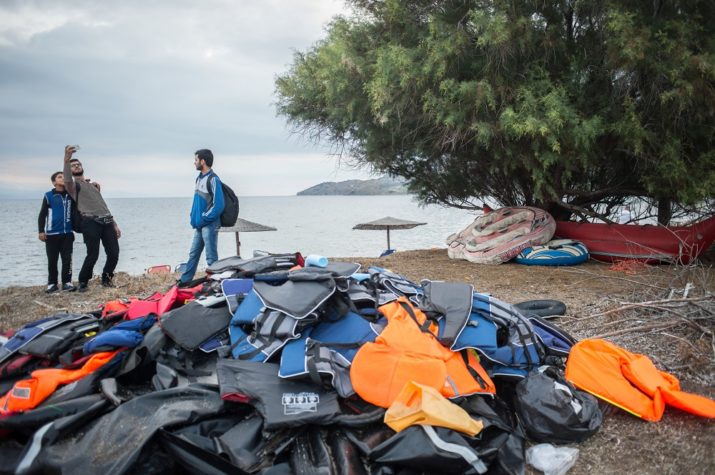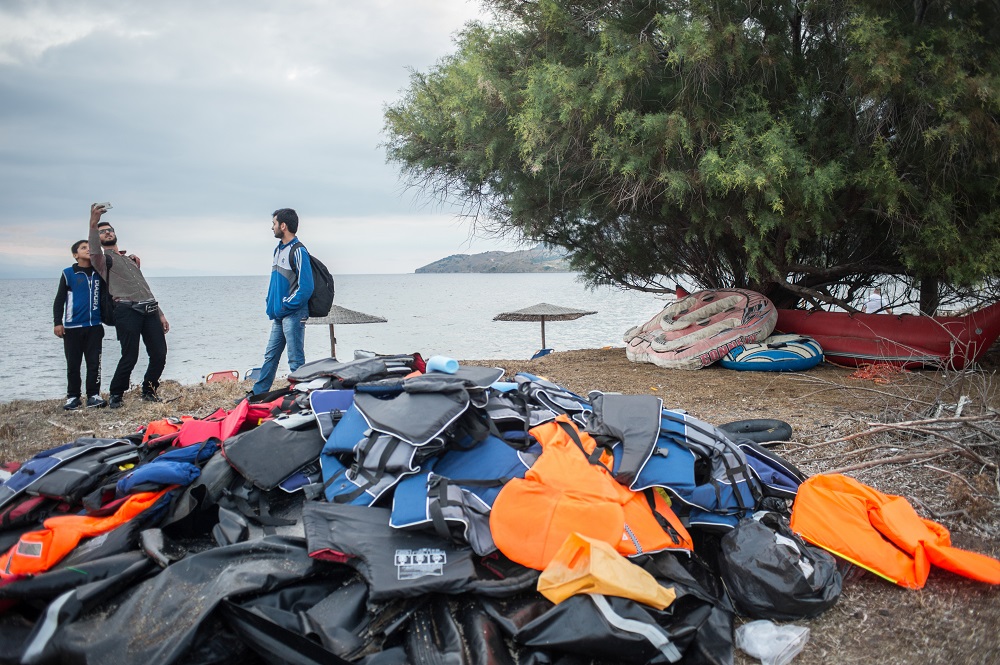

This is part of our special feature on Anxiety Culture.
“The problems generated by the current ‘migration crisis’, and exacerbated by migration panic, belong to the category of the most complex and controversial: in them, the categorical imperative of morality comes into direct confrontation with the fear of the ‘great unknown’ epitomized by the masses of strangers at the gate. Impulsive fear aroused by the sight of the aliens bearing inscrutable dangers enters combat with the moral impulse prompted by the sight of human misery.” (Bauman, 2016, p. 106)
The speed and instantaneousness of connectivity allowed by new media technologies has drastically changed the way in which migration is experienced and accounted for. Mobile phone networks are now ubiquitous and promise users to bridge physical distance through digital proximity, compressing space and time. These affordances are now readily available and easily affordable for multiple groups across the north-south divide of the globe.
This makes the recent refugee crisis in Europe the first of its kind in a fully digital age. This has meant that migrants have been able to use new digital affordances as an aid in risky transnational crossings, keeping in touch with their loved ones left behind, but also with their peers who have successfully arrived in the destination countries. We are now talking of modern migration and of “connected migrants,” as attested to in the manifesto by Dana Diminescu (2008). Phones, social media, mobile apps, online maps, instant messaging, translation websites, wire money transfers, mobile phone charging stations, and Wi-Fi hotspots have created a new infrastructure for movement as critical as pathways and air routes. Together, these technologies make up a digital passage (Latonero and Kift, 2018; Gillespie et al., 2018) that is not only facilitating, but also accelerating the massive flow of people from places like Syria, Iraq, and Afghanistan to Greece, Germany, and Sweden.
The tools that speed up this passage provide many benefits, but they are also used to exploit refugees, and they raise questions about surveillance. Mobile phones and messaging services like Viber, Snapchat, and FaceTime are a primary means for smugglers to organize illicit crossings via lorries, rubber boats, and dinghies. Refugees are therefore also most vulnerable to manipulation or crimes enabled by digital connectivity. This digital data leaves traces that also allow the refugees to be tracked and monitored. This data is often used for preventive policing, racial profiling, securitization, and antiterrorism measures by border control agencies (Broeders, 2009; Leurs & Shepherd, 2017). But these digital traces are also picked up for commercial purposes by companies such as Facebook, Google, Vodafone, and Western Union, which are starting to explore how technology can address refugee issues directly. Even in the case of dramatic passages, the so-called MIC, or Migrant Industry of Connectivity (Gordano Peile, 2014), is able to organize a vast array of services that target and benefit from migration as a main source of transactions.
But technologies also provide new forms of survival and lifelines. The very same data and signals that can be processed for border surveillance and by commercial partners can be picked up by NGOs trying to rescue boats crossing the Mediterranean, often intervening before the official EU operators. This has recently caused a huge legal stand-off between the Italian government and international NGOs, who have been accused of facilitating the operation of smugglers in the name of humanitarian aid, by circumventing the European Union’s harsher regimes for control, monitoring, and rejection, such as Frontex and Eurodac. Furthermore, digital technologies are crucial, not only because of logistic and economic considerations, but also for affective reasons, as they foster a globally mediatized exchange not only of information but also of emotions (Tettegah, 2016; Papacharissi, 2014, 2015; Kunstman, 2012; Garde-Hansen & Gorton 2013). Thanks to new technologies, migrants are now able to determine their routes via GPS and alter their journey on the basis of information gathered on social media, but also send home their first selfies once they manage to reach their destination, in order to maintain affective connections that go beyond and/or challenge constructions of conventional long-distance relations and belonging.
Therefore, the combination of technology and migration deserves further scrutiny as it has not only allowed new opportunities for diasporic communities to stay in touch but has also generated new anxieties and fears. Recent media images of refugees reaching dry land and taking selfies, for example, have sparked heated debates on whether these refugees are worthy of aid and support (Ticktin, 2016; Chouliaraki, 2017; Risam, 2018). At the height of the so-called ‘”European refugee crisis.” news headlines and social media tropes commonly put asylum seekers who crossed European borders with their smartphones in the spotlight, questioning their motivations and credentials. The British tabloid the Express prominently displayed an image of Syrian men posing for a picture using a selfie stick, with the following commentary:
Migrant crisis: Are these happy young men really timid souls fleeing war and persecution? They aren’t quite the heart-rending image of dishevelled, traumatized refugees fleeing the horrors of their war-torn home country one might expect. (Express, 2015)
This media framing posits the new “connected migrant” as a bogus refugee, for the simple reason that their reasonable economic status and level of education could not be seen as compatible with the need to escape war-torn regions where human rights are infringed on a daily basis. This is based on the assumption that refugees should be innocent victims, helpless, and disenfranchised, in order to fit with the claim for humanitarian help bestowed by the West. As Ticktin writes:
[i]n other words, humanitarianism requires innocent sufferers to be represented in the passivity of their suffering, not in the action they take to confront and escape (Ticktin, 2016, p. 259).
Images of refugees as technologically savvy and digital natives have instead generated fear and anxiety about an invasion of bogus refugees, which feeds into a process of othering that could be summarized as “high tech orientalism” (Chun, 2006, p. 73).
The fear of the other, as embedded through technological difference or sameness, is to be understood as part of a longer history of anxiety surrounding transnational migration and their chosen forms of communication for “ethnic” families. In the past, fears were projected onto the many satellite dishes that seemed to mark multicultural neighborhoods as a threshold to integration (Georgiou, 2006, Slade, 2014). Separate use of media, languages, and religion was often seen as a form of “enclavization,” alterity, segregation and the failure of multiculturalism (Sjöberg & Rydin, 2011, p. 238). Technology use, in particular among non-elite migrants, is treated with suspicion, whereas hyper-mobile global nomadic expatriate groups are commonly celebrated (Leurs & Ponzanesi, 2018).
Lilie Chouliaraki, for example, studied the ways in which selfies were mobilized in a new form of geopolitical “symbolic bordering” (Chouliaraki, 2017), triggering fear of undesired others. She identified selfies as pertaining to three different categories or representations: 1 – refugees taking selfies (for example upon safely reaching dry land); 2 –solidarity selfies of migrants with Western figures of authority (such as the famous selfies with Angela Merkel and Pope Francis); 3 – celebrity selfies in support of migrants’ pleas (such as the images from the Berlin Film Festival Gala staged by the human rights artist Ai Wei Wei, with celebrities such as the actress Charlize Theron and Pussy Riot’s Nadya Tolokonnikova taking selfies in refugee jackets).[1] But what is missing in each category are the original selfies taken by the migrants themselves. What we see in the media is a remediation of the selfie taken by the migrants, what Chouliaraki calls “migrant-related selfies.” The migrant becomes the object of representation and his/her agency is once more erased:
The migrant selfie, I argue, expands existing literature, by showing how the selfie operates as a technology of power that contributes to orientalist agendas that ‘other’ migrants and refugees; it does so by coupling the geopolitical bordering of migrants stuck in the outskirts of Europe (Vaughan-Williams, 2009) with practices of ‘symbolic bordering’ that appropriate, marginalize, or displace their digital testimonies in Western news media. (Chouliaraki, 2017, p. 78)
Elaborating on Chouliaraki’s analysis, Roopika Risam argues that the absence of that image — the selfies produced by the migrants themselves — keeps it outside the circuit of the Western media, therefore forging a politics of refusal of being appropriated and manipulated. As Risam writes:
I suggest that by virtue of their invisibility in news media analyzed here, refugee selfies lay claim to self-representation, reasserting the subjectivity and humanity of the refugee and constituting a bold reclamation of identity that challenges the subject–object binary created by circulation of the migrant-related selfie. (Risam, 2018, p. 59).
By staying out of sight of Western media, migrant selfies remain something for the community and for staying in touch with each other, therefore shielded from the adverse politics and critique mentioned by Chouliaraki above.
These different positions refer to the role of mainstream Western media vis-à-vis the migrant crisis and the take on distant suffering that comes too close (and therefore generates a moral panic) versus a postcolonial approach that takes into consideration the agency of migrants and their repurposing of technology, not as something particularly new or disconnected from the offline world, but as part of everyday life, producing important but also banal communities on the move.
A postcolonial intervention into the burgeoning field of digital diaspora studies is necessary to avoid having the emerging field adopt a media-centric reasoning that glosses over the ways in which everyday offline and online contexts are steeped in intersecting gendered, racial, classed, generational and geo-political power differentials (Candidatu, Leurs & Ponzanesi, forthcoming). While the world might appear globally interconnected thanks to new technologies and modes of transportations, of course the capacity to migrate and establish networks of belonging remains unevenly distributed.
When applied to migrant culture, digital diaspora becomes even more relevant as it allows the intertwining of traditional notions of diaspora as connected to ethnic ties (the linkage to a homeland and the relation to its symbolic discourses of national belonging) with a diaspora of connections, which refers to intersecting and participating with other, new forms of global diasporas. The first implies a form of bonding in order to keep the relationship with already established structural ties with the homeland, creating at times forms of ethnic encapsulation, whereas the notion of bridging explores new connections and possibilities for cosmopolitanization. These two constructs, namely “the cosmopolitan Self” and the “encapsulated Self,” are not mutually exclusive but can operate simultaneously (Christensen & Jansson, 2015).
This approach is central to our project “CONNECTINGEUROPE,” which allows us to explore the role that digital technologies, especially social media, play in the lives of migrants. We focus on how, via “digital diasporas,” migrants create “communities of belonging” to reaffirm connections with their homeland, but also to establish new relations in the host countries. By examining diasporic networks and their use of the internet and social-networking sites, we explore how digital participation can facilitate cultural encounters, social cohesion, intercultural communication and emancipation in Europe, as well as how, conversely it can lead to forms of resistance, retreat and alternative discourses of Europeanness and European identity (Alinejad et al., 2018).[2]
The status of Europe, which is supposed to welcome so-called “legitimate” refugees, is itself so very precarious at the moment; instead of identification with the needy, this has led to antagonism, ambivalence and fear, often erupting into pure xenophobia, expertly manipulated by right-wing demagogues and anti-immigration parties — what Zygmunt Bauman has called a “moral panic” in his latest book Strangers at our Door.
This is also due to what Arjun Appadurai has defined as the Fear of Small Numbers (2006), because this anxiety is not justified by the low numbers of actual border-crossers. However, the old process of migration to Europe has become a site of a narrative panic since 2015, because it brings with it new anxieties about identity, sovereignty, economic effects and citizenship. Modern nation states are created by fixed narratives of blood, religion, language and territory, while forced refugees destabilize all these notions because they have a narrative but they are not identified as characters with a name. Their presence destabilizes the sovereignty of the nation state by posing a threat to its cohesion. Accordingly, modern nation states feel constantly obliged to drive out those who fall into territorial ambiguity.[3] Refugees represent the anxiety of incompleteness, which propels a desire for the elimination of difference. This difference is often embodied by “biominorities,” by which Appadurai means those whose difference (ethnic, religious, racial) from the national majorities is seen as a form of bodily threat to the national ethnos.[4] These small numbers represent a “tiny obstacle” to total purity. Minorities become, therefore, the scapegoat for larger social problems, creating uncertainty and a social geography of anger. Our reality of movements and mixtures, of unclear and ever-shifting boundaries, accentuated by media representations, has sparked a notion of uncertainty, creating “profound doubts about who exactly are among the ‘we’ and who are among the ‘they’” (Appadurai, 2006, p. 5). These anxieties are not so much about religion and security as they are about paranoid and/or predatory nation states (Appadurai, 2018).[5]
This article has claimed that technologies offer new tools for engaging in transnational cosmopolitan alliances to overcome this moral panic but that the speed, uncontrollability and unpredictability of these flows have also generated new sources of anxiety and resistance to these digital strangers at our door. As Beck writes, it is now “individuals who are charged with the all but unfulfillable task of finding, individually, solutions to socially produced problems” (In Bauman, 2016, p. 56). The task of tackling the problems generated by existential uncertainty with the eminently inadequate resources commanded by individuals on their own is the challenge of our times that poses individualism through consumerism as a central subject of a global modernity that has turned dark. To conclude with the wise words of the late Bauman:
Devoured by that diffuse, dissipated and scattered fear that infiltrates and penetrates the whole of the life setting and the totality of life-pursuits, as capillary vessels do the totality of the living body, humans are abandoned to their own resources – puny and miserable flimsy assets by comparison with the grandiosity of existential liabilities. (Bauman, 2016, p. 56)
Sandra Ponzanesi is Professor of Gender and Postcolonial Studies at Utrecht University, the Netherlands. She has published widely on postcolonial theory, migration studies, postcolonial Europe, cinema and digital migration. She is PI of the ERC project CONNECTINGEUROPE ‘Digital Crossings in Europe. Gender, Diaspora and Belonging.’
Photo: Lesbos, Greece – September 29, 2015: Refugees take selfies on the shore after getting off the boat from Turkey
References:
[1] https://www.independent.co.uk/arts-entertainment/art/news/ai-weiwei-made-a-room-full-of-celebrities-take-selfies-in-refugee-jackets-a6881266.html
[2] For more information visit http://connectingeuropeproject.eu
[3] Arjun Appadurai, “Narrative Panic and the Edges of Europe.” Keynote address. Conference ‘Migration and Mobility in a Digital Age’. Heyman Center for the Humanities, Columbia University, 10-11 April, 2018. See: http://heymancenter.org/events/migration-in-a-digital-age-paradoxes-of-connectivity-and-belonging/
[4] Arjun Appadurai, “Across the world, genocidal states are attacking Muslims. Is Islam really their target?” Scroll.in, Tuesday, 5 June 2018. See: https://scroll.in/article/879591/from-israel-to-myanmar-genocidal-projects-are-less-about-religion-and-more-about-predatory-states
[5] See note 4.
Alinejad, Donya, Laura Candidatu, Melis Mevsimler, Claudia Minchilli, Sandra Ponzanesi and Fernando van der Vlist 2018. Diaspora and Mapping Methodologies. Tracing Transnational Digital Connections with “Mattering Maps”. Global Networks. A Journal of Transnational Affair. 23 May.
Appadurai, Arjun, Fear of Small Numbers: An Essay on the Geographical of Anger. (Durham: Duke University Press, 2006).
Bauman, Zygmunt. Strangers at Our Door (Cambridge, UK: Polity Press, 2016).
Beck, Ulrich. Risk Society: Towards a New Modernity (London: Sage, 1992).
Broeders, Dennis. Breaking Down Anonimity. Digital Surveillance of Irregular Migrants in Germany and the Netherlands. (Amsterdam: Amsterdam University Press, 2009).
Candidatu, Laura, Leurs, Koen & Ponzanesi, Sandra. (forthcoming 2018). ‘Digital Diaspora Beyond the Buzzword.” In Roza Tsagarousianou & Jessica Retis. The Handbook of Diasporas, Media, and Culture. New Jersey, NJ: Wiley-Blackwell.
Christensen, Miyase & Jansson, André. Cosmopolitanism and the Media: Cartographies of Change. (Basingstoke Houndmills: Palgrave MacMillan, 2015).
Chouliaraki, Lilie 2017. Symbolic Bordering: The Self-representation of Migrants and Refugees in Digital News. Popular Communication, 15 (2), pp. 78–94.
Chouliaraki, Lilie. Spectatorship of Suffering. (London: Sage, 2006).
Chun, Wendy. K. Freedom and Control: Power and Paranoia in the Age of Fiber Optics. (Cambridge, MA: MIT Press, 2006).
Diminescu, Dana 2008. The Connected Migrant: An Epistemological Manifesto. Social Science Information, 47 (4), pp. 565–579.
Garde-Hansen, Joanne & Gorton, Kristyn. Emotion online: Theorizing Affect on the Internet. (New York: Palgrave Macmillan, 2013).
Georgiou, Myria. Diaspora, Identity and the Media: Diasporic Transnationalism and Mediated Spatialities. (Cresskill, NJ: Hampton Press, 2006).
Gillespie, Maria, Osseiran, Souad and Cheesman, Margie 2018. Syrian Refugees and the Digital Passage to Europe: Smartphone Infrastructures and Affordances. Social Media & Society, January-March, pp. 1–12.
Gordano Peile, Cecilia 2014. The Migration Industry of Connectivity Services: A Critical Discourse Approach to the Spanish Case in a European Perspective. Crossings. Journal of Migration and Culture, 5 (1), pp. 57-71.
Kuntsman, Adi. ‘Introduction: Affective Fabrics of Digital Cultures.’ In Athina Karatzogianni & Adi Kuntsman (Eds.), Digital Cultures and the Politics of Emotion. (Basingstoke Houndmills: Palgrave Macmillan, 2012), 1-7.
Latonero, Mark & Kift, Paula 2018. On Digital Passages and Borders. Refugees and the New Infrastructure for Movement and Control. Social Media & Society, January-March, pp. 1–11
Leurs, Koen & Shepherd, Tania. (2017). ‘Datafication and Discrimination.’ In: Karin van Es & Mirko Tobias Schaefer (Eds.) The Datafied Society. Studying Culture Through Data. Amsterdam: Amsterdam University Press, pp. 211-233.
Papacharissi, Zizzi. Affective Publics: Sentiment, Technology, and Politics. (Oxford: Oxford University Press, 2014).
Papacharissi, Zizzi 2015. Affective Publics and Structures of Storytelling: Sentiment, Events and Mediality. Information, Communication & Society, 19, pp. 307-324.
Risam, Roopika 2018. Now You See Them: Self-Representation and the Refugee Selfie. Popular Communication, 16 (1), pp. 58-71.
Ticktin, Miriam 2016. Thinking Beyond Humanitarian Borders. Social Research, 83 (2), pp. 255–271.
Slade, Christina. Watching Arabic Television in Europe. From Diaspora to Hybrid Citizens. (Basingstoke Houndmills: Palgrave Macmillan, 2014).
Sjöberg, Ursula & Rydin, Ingegerd. (2011). ‘Everyday Mediated Practices of Citizenship: Struggling with a New Language and Culture Through Media.’ In Elisabeth Eide & Kaarina Nikunen (eds.), Media in Motion. Cultural Complexity and Migration in the Nordic Region. Farnham: Ashgate, pp. 237-253.
Tettegah, Sharon. Emotions, Technology, and Social Media. (London: Elsevier Academic Press, 2016).
Published on July 2, 2018.




